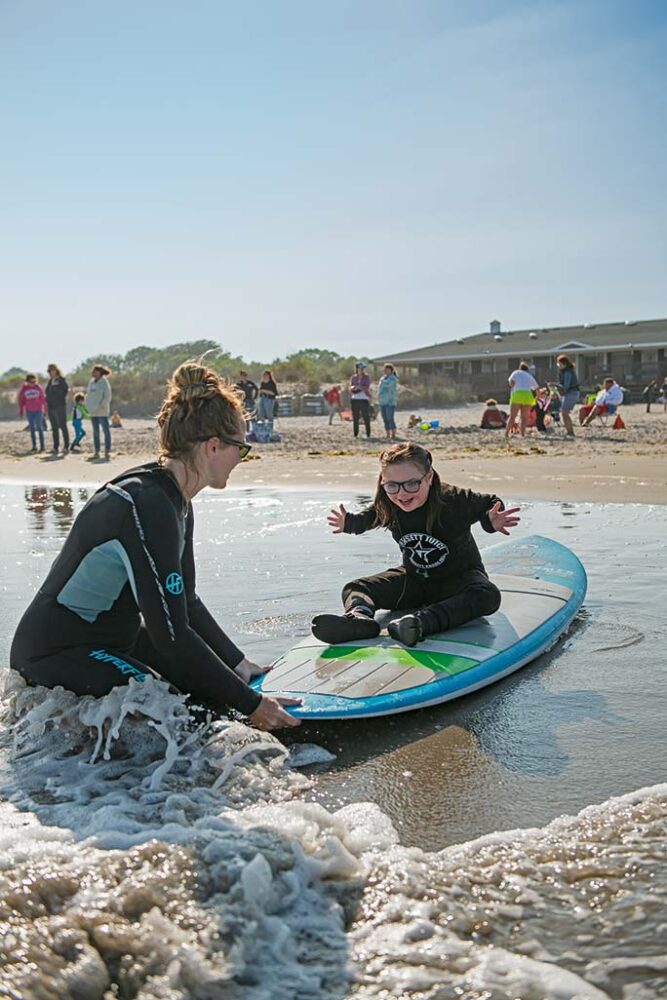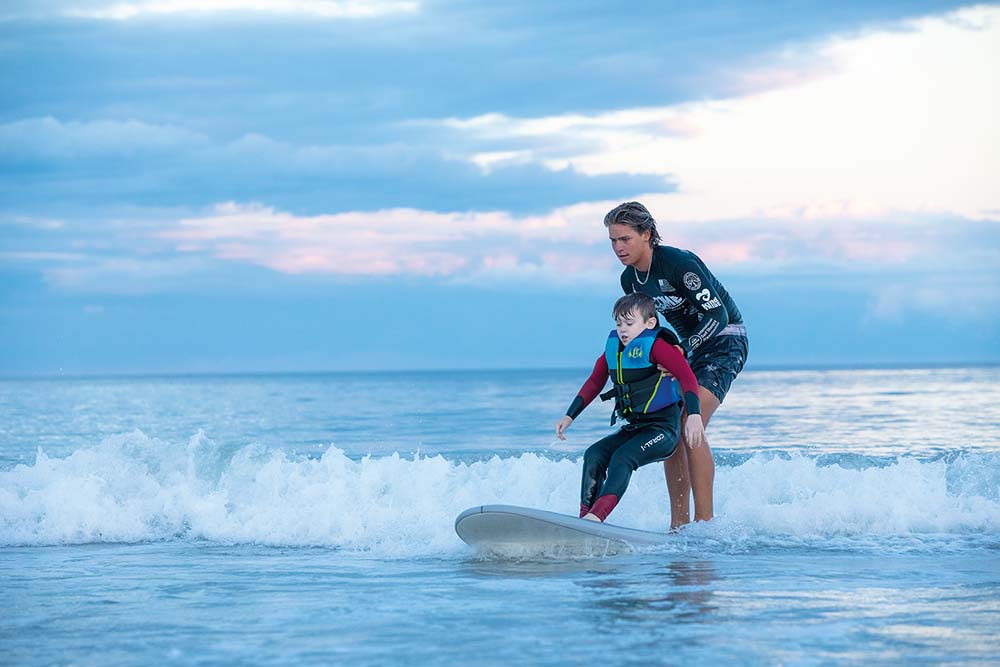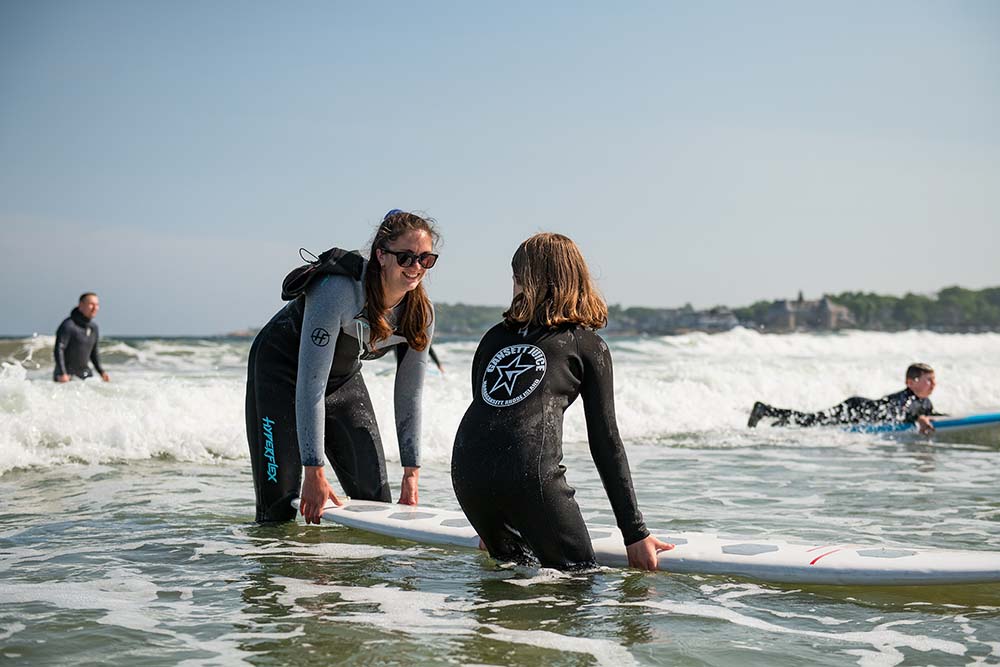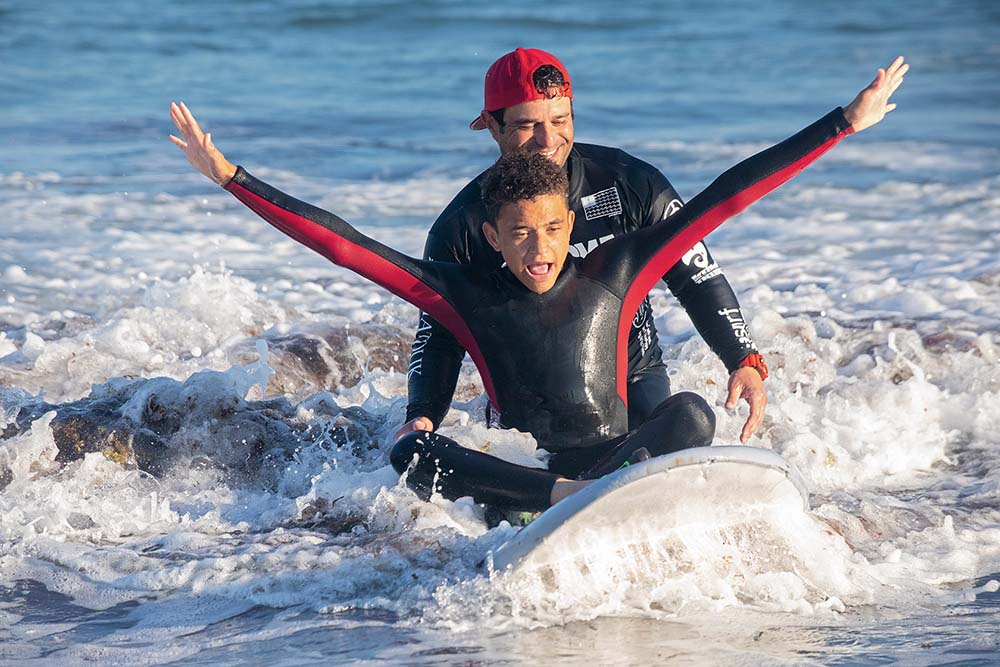Catching Waves for Heath
The power of surf therapy
By Meredith HaasGnome Surf instructor Ivan Tripp assists a young athlete during a lesson. Photograph courtesy of Gnome Surf.
Although the days are getting warmer, the ocean has yet to catch up. But on this afternoon, that isn’t stopping anyone from getting their feet wet.
More than 20 kids with their families and surf instructors congregate in front of the pavilion at Narragansett Town Beach on a hazy Wednesday in late May. It’s the first day of this season’s surf therapy program sponsored by the University of Rhode Island for kids with disabilities, and everyone is excited to be outside.
“He doesn’t have booties on, but he hasn’t come out of the water yet,” laughs Charles Tabor as he and his wife watch their 11-year-old son, who otherwise is in a full wetsuit, play in the water barefoot while sitting on top of a surfboard as an instructor pulls him around.
“He’s getting his full hour in.”
“He didn’t start talking until he was seven,” adds Mary Tabor. “He’s becoming very social now with everything, so we’re trying to incorporate that with playing with others.”
Like the Tabors’ son, many kids participating in this program are on the neurodivergent spectrum, which includes Down syndrome, autism spectrum disorder, attention deficit/hyperactivity disorder, cerebral palsy, and developmental delays. People with these conditions may have a heightened sensory awareness, making bright lights, loud noises, or changes in routine overwhelming and stressful. Although responses vary, repetitive behaviors, social challenges, and difficulty with verbal communication can be common.
Mary Tabor has been pleased with her son’s initial response to the surfing program, making it worth the drive from where they live in Ashaway.
“He loves the water, so this is perfect for him. He was so excited when he got out, he was like, ‘This is an epic day.’”
Barbara Caron of South Kingstown, whose son is on the autism spectrum and participated in the surf therapy program a few years ago, says that water has always had a calming effect on him.
“I remember when he was born; in the hospital, he was crying inconsolably. So the nurse took him and laid him across her forearm with his head in her hand. She ran warm water from the sink over his forehead, and it calmed him immediately,” she recalls.
When he was a teenager, she was not surprised by his response to the surf therapy program. “Surfing and being in the water can be so therapeutic, and I definitely saw that with him. He just really enjoyed being in the water.”
Emily Clapham also appreciates the mental and physical benefits of surfing.
“If I’m stressed out or super anxious about something, I will spend time at the beach or in the water surfing … it’s way more impactful than any pill you can take,” says Clapham, an associate professor of health sciences and coordinator of the Adapted Physical Education (APE) Program in the URI School of Education, who runs the surf therapy program.

An instructor helps a participant acclimate to the water at URI’s surf therapy program. Photograph by Cate Brown.
She grew up enjoying the water in Westerly with her parents, sister, and grandparents but discovered surfing in high school during a family trip to Hawaii. That trip would eventually spark her lifelong love of the sport as well as a career studying the health benefits of surfing.
According to her research, individuals with sensory, intellectual, or physical challenges are often less engaged in physical and outdoor activities, which is linked to higher rates of obesity, diabetes, and other chronic diseases. So she designed the surf therapy program 13 years ago as an added component to URI’s APE program to help improve both physical fitness and mental well-being for children with a variety of disabilities.
“When I started my position at URI, I was [put in charge of] an adapted physical education community outreach program, and I thought, ‘you know, this would be so cool if we took all these kids to the beach and took them surfing.’ So I just piloted it, and it was a big hit,” Clapham says.
URI Surf Therapy Program is one of many programs helping engage individuals with sensory, intellectual, or physical challenges in physical and outdoor activities, which is linked to higher rates of obesity, diabetes, and other chronic diseases.
Photograph by Cate Brown
Emergence of Surf Therapy
The concept of surf therapy and its potential benefits has emerged over the last several years with many surfing nonprofits and camps popping up across the United States. One of the earliest camps, Surfers Healing Camp, was founded in 1996 by Israel “Izzy” Paskowitz—a former professional surfer from Hawaii—for his son who was diagnosed with autism at age three. AmpSurf and the ParaSurf League formed in 2003 for veterans and first responders who suffer from post-traumatic stress, who are amputees, or who are visually or hearing impaired. Life Rolls On is another program developed for those living with some degree of paralysis and ran its first event in Narragansett in 2022.
The International Surf Therapy Organization, which formed in 2017 to build and connect this global community, defines surf therapy as a “therapeutic intervention that combines surf instruction/surfing and structured and/or group activities to promote psychological, physical, and psychosocial well-being.”
Unlike more traditional talk therapy approaches, surf therapy anchors its method on physical activity. And while the success of these programs has been largely anecdotal, Clapham has been contributing to the nascent research on the physiological benefits that support this approach.
She recently published a book on the topic that is the first of its kind. “It’s a culmination of data collected over the years that demonstrates the benefits of surf therapy and how to implement programs … Now there are tons of researchers that are looking into this. I love to see the growth and that people really recognize it now as a therapeutic modality.”
Her research has shown that surfing improves upper body and core strength, flexibility, range of motion, coordination, endurance, and bone density, and reduces body fat. Anecdotal evidence from parents, instructors, and teachers has revealed an increase in self-confidence, gains in social development, and decreased anxiety in the children participating.
Parents report their children are performing better in school because they’re calmer and more relaxed, says Clapham. “[It provides a routine] and takes a little of the edge off. That’s what [surfing] does for me, too.”
Clapham’s research also documented increased verbalization, excitement and motivation about physical activity, and improvements in surfing skills. Several of these outcomes were also reported to carry over into other areas of the participants’ lives, including increased participation and improved performance in other physical activities such as APE classes, the Special Olympics, and Unified Sports.
“Many children, especially children with autism spectrum disorder, get into a routine that’s hard to break out of,’’ says Clapham. “It’s even difficult to get them engaged in physical activity. Our research on surf therapy demonstrates that surfing empowers [them] with the willingness to try new things. It also allows them to interact with their peers and teachers and be physically active at the same time, improving psychomotor and social skills simultaneously.’’
This is also true for the volunteers or instructors engaging with the kids, or athletes, as Ivan Tripp says.
“All of the athletes have different ways of connecting,” he says, “whether it’s talking about a TV show that they like, or their favorite lunch, or a video game. Or not talking at all because some athletes are nonverbal, which was definitely hard for me to understand in the beginning. It’s more connection through eye contact and body language. And I think that all those things have helped me in my everyday life to connect with people that I don’t know.”
At 16, Tripp has been a lead surf instructor with Gnome Surf, a nonprofit surf therapy organization based in Little Compton, for the last two years.
You have to meet athletes where they are and realize what they want personally.

Photography courtesy of Gnome Surf
“We work with kids of all abilities. Sometimes they’re neurodivergent. Sometimes they’re neurotypical. We have kids who have trauma, depression, anxiety, autism, Down syndrome, ADHD. So I think that, you know, it’s just realizing that it is for everyone,” he adds, explaining that it’s important to adjust instruction to everyone’s needs and wants.
“You have to meet athletes where they are and realize what they want personally. And being a sort of therapy instructor, you’re helping them feel comfortable, which I think sometimes can be hard for kids, especially with the water. We get a lot of athletes that are really afraid of water. So sometimes athletes don’t end up going in. And we just connect on the beach, or in the shallower parts.”
Tripp is also an avid surfer and says that surfing has helped him manage his ADHD by providing an outlet to let his mind wander and relax, as well as helped him come to terms with his own ability.
“I think it’s realizing that [ADHD] is not a negative that I have. I don’t know what it’s like to not have ADHD, but I’m happy that it can help me focus on certain things in the ocean, where I don’t get very distracted,” he says. “Being able to give that back and share the same joy I feel with kids of all abilities is really nice.”
Tripp’s mother, Dawn Tripp, says his experience and perspective have been a huge strength in helping him connect with the other kids in the program.
“It’s been really interesting that his work with kids with a range of abilities has allowed him to see something that for a long time he saw as a disability, is something that actually provides him kind of entree into a different type of experiential place,” she says.
Chris Antao founded Gnome Surf in 2015 and says that while growing up with undiagnosed ADHD, surfing “was the only time I felt at peace, and it improved my self-confidence tremendously. So I knew I needed to share this gift with kids.”
Since then, the program has expanded to Second Beach in Middletown, Westerly, and Westport, Massachusetts—as well as to other states across the country. Gnome Surf also has dedicated programs for LGBTQ and BIPOC youth.
“It’s pretty wild what’s happened,” Antao says. “The power of the ocean and surf therapy extends not only to the athlete that we’re serving, but also to the families. It’s building a community, a support network, and friendships.”
Mary Tabor echoes the same sentiment in that these types of programs have been very helpful not only to her son, but to their family. “We’ve gained some really great friends,” she says. “It’s important ourselves to be social.”
Teaching the Teacher
The surf therapy program is one of several in the URI APE program that offers URI students APE credits.
John Hogan, a middle school teacher and coach in North Providence, enrolled in Clapham’s surf therapy program to gain APE certification.
“I’ve been teaching for 27 years and see the need for more people certified in adapted [physical education],” he says.
Gnome Surf trains and mentors younger instructors like Tripp, many of whom participated in the program themselves.
“We’re working to guide youth in these areas and teach them how to utilize the ocean as a form of blue economy for them going forward,” says Antao. “This season, we are focusing on junior instructors, giving at-risk youth transferable skills, [and] we can hopefully mentor and guide them to be eventual surf instructors with us as well.”

Photograph by Cate Brown
Facing Barriers
Both programs rely on grant funding and outside support to ensure all families can access them.
“I have always been able to secure grant funding every summer,” says Clapham, whose program is free for participants. “I work on several grants at a time, and it just keeps working out. So we’ve been really fortunate to keep it going.”
While Gnome Surf does receive some grant funding they also charge fees for lessons.
“A lot of kids are covered through [grant] funding, but some of it is private pay,” says Antao. “But we offer free camps on the weekends, and if a child can’t afford it, we do have a tiered system. We’re working hard with corporate sponsors and grants to ensure that [the program] is affordable and accessible to all families, regardless of their socioeconomic status.”
Fundraising is only one of the challenges facing these programs. For Antao, coastal access in Rhode Island has been one of the biggest obstacles. And while he is grateful to the towns where he currently operates, he says the process is still burdensome.
“We have to jump through hoops to be able to get the permitting to operate on beaches, and it should be easier, especially for what we’re doing,” he says. “We’d love for the state to step in and help us with accessibility to the beaches … because who knows when someone says ‘no,’ and then that shuts the door on hundreds or thousands of kids.”
Who knows when someone says ‘no,’ and then that shuts the door on hundreds or thousands of kids.

Photograph courtesy of Gnome Surf
And while both Antao and Clapham note that swimming is not a requirement to participate in these surf therapy programs given the use of life jackets and 1:1 instructor-to-student ratios, the perception of safety and swimming ability can prevent families from even considering joining.
“We have identified swimming as an issue for at-risk youth, primarily in the BIPOC populations, due to systemic racism,” Antao says. “So we’re trying to incorporate a learn-to-swim component [and] we’re also partnering with the YMCA to develop programs [where kids start in the pool]. The next step is surfing in the ocean and teaching them how to swim there.”
Hogan points out another challenge from his experience teaching.
“A lot of people are wary of working with the adapted community, thinking, ‘They can’t do this, or they can’t do that. Will they be able to understand? Will they get injured?’” he explains. “I think people are worried about being responsible [and doing harm] … out of fear from not knowing what it’s all about.”
And while there are inherent dangers with surfing, Clapham agrees that physical or neurological disabilities shouldn’t be a barrier to something so rewarding.
“People can be overly cautious when they hear the word ‘disability,’ but we just have to become, I think, as a society more comfortable with people that are atypical. It’s okay, you know. We’re all in this together.”
Contact Us
Telephone: (401) 874-6805
Email: allard@uri.edu
Contributor Guidelines
Please review submission guidelines to be considered. d


